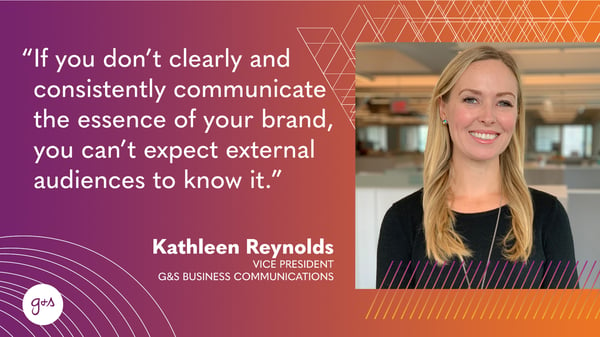*A version of this article was originally published in PR Daily on September 10, 2020.
What does your company do? What’s your brand’s mission? What is your brand known for?
If these questions stumped you, you’re probably not alone. But the goal is to have strong, succinct answers at the ready. Perhaps, like many professionals, you drew a blank or found many thoughts flooding in at once. If you “aced” the quiz, you can advance to the next level. Try asking your team to answer these questions in an upcoming meeting. Would their answers be uniform or all over the map? Would the things they highlight align with the information on your website or sales collateral? Would the answers come naturally to them, or would they fumble for a response?
Not many organizations nail that level of internal brand alignment and education. But if yours does, level up again. What if I asked some of your clients or prospects to answer basic questions about your brand? Does this idea give you pause? They WILL have answers. But those answers may surprise you. If you don’t clearly and consistently communicate the essence of your brand, you can’t expect external audiences to know it. They will fill in the blanks on their own.
Companies who proceed without brand clarity do so at their own peril. That’s especially true in 2020, when budgets are strapped and attention spans are short. Your brand messaging must be highly relevant and memorable to break through. But how do you get there?
Keep It Simple
When I’m working on a big idea for an important audience – whether for a reporter, prospect, client or colleague – I like to run a “keep it simple” diagnostic with one of my most valuable advisors. This process helps me assess whether my message is clear or needs refining (usually because it’s overcomplicated or contains too much information).

Here’s how the process works. I give myself a minute to articulate the core concept and call to action. My advisor excels at providing unfiltered feedback and asks questions that may pick my idea apart. At the end of my pitch, he articulates what stood out most to him. If he does so effectively, I smile. If he loses the thread, I sigh. Not because he messed up, but because I failed to present a cohesive message.
This advisor is one of my favorite “keep it simple” sounding boards because he’s smart, curious, funny – and my seven-year-old son. If you remember one thing from this article, it should be this: The “Keep It Simple” approach works with almost any big idea or brand strategy. If a smart kid can’t comprehend and repeat it back, then “it” needs more work.
“Shape” Your Brand Strategy
To help you focus and “keep it simple,” you can try another approach to “shape” your brand strategy. That shape is a (message) triangle.
Imagine a basic triangle shape. You have your three sides with open space at the center. At G&S, we advise people to think about that open space inside the triangle first. Come up with the statement that speaks to the core of your brand’s purpose – the foundation of what your company aims to deliver. Then work out and fill in the three sides of the triangle. The sides of the triangle demonstrate the three most important manifestations of that brand purpose or promise. Approach this basic brand geometry strategically, by getting input from your best people and partners. This will keep you honest and help you refine the triangle accordingly.
We worked with our client INSIGHTEC to distill an entire universe of their innovation into a triangle to keep us focused. The medtech pioneer narrowed its complex technology value proposition into more emotionally-resonant messaging that could communicate that value to inspire action among key audiences and make a real difference in patients’ lives.


This streamlined messaging approach has proven useful to countless clients: founders preparing for a first-round funding interview, multinational real estate conglomerates looking to communicate the value of the parent company in a cohesive way, or financial services companies that need to simplify a complex array of services into a humanized narrative that everyone remembers.
If you can make the triangle stick in your memory, you then have the freedom to build on it in conversations, filling in each angle with anecdotes, customer stories, statistics and more. It creates confidence in your delivery, too: When you know your core brand promise and the three key supporting values, you'll be anchored in your message no matter where a conversation leads.
Just TRI It
The beautiful challenge of the triangle is the forced simplicity – after all, it’s not a brand octagon. Keep your message triangle tight and streamlined to make your brand’s most vital attributes memorable. Aligning on what to include in the brand triangle may generate different answers or outcomes from different professionals on your team. This is a key part of the process as you collaborate to narrow this messaging to discover your brand essence. This work will lead you to learn, optimize and amplify what makes your brand unique.
Ultimately, a message triangle that can be easily remembered and incorporated into daily communications – both internal and external – is a powerful way to centralize and streamline your key messages. Just TRI it.